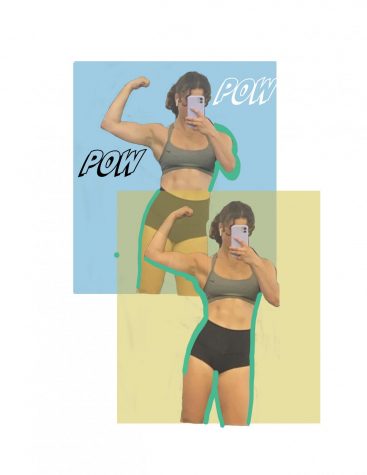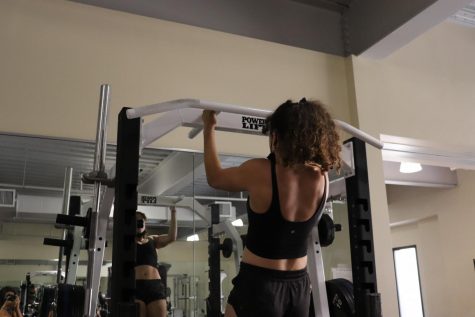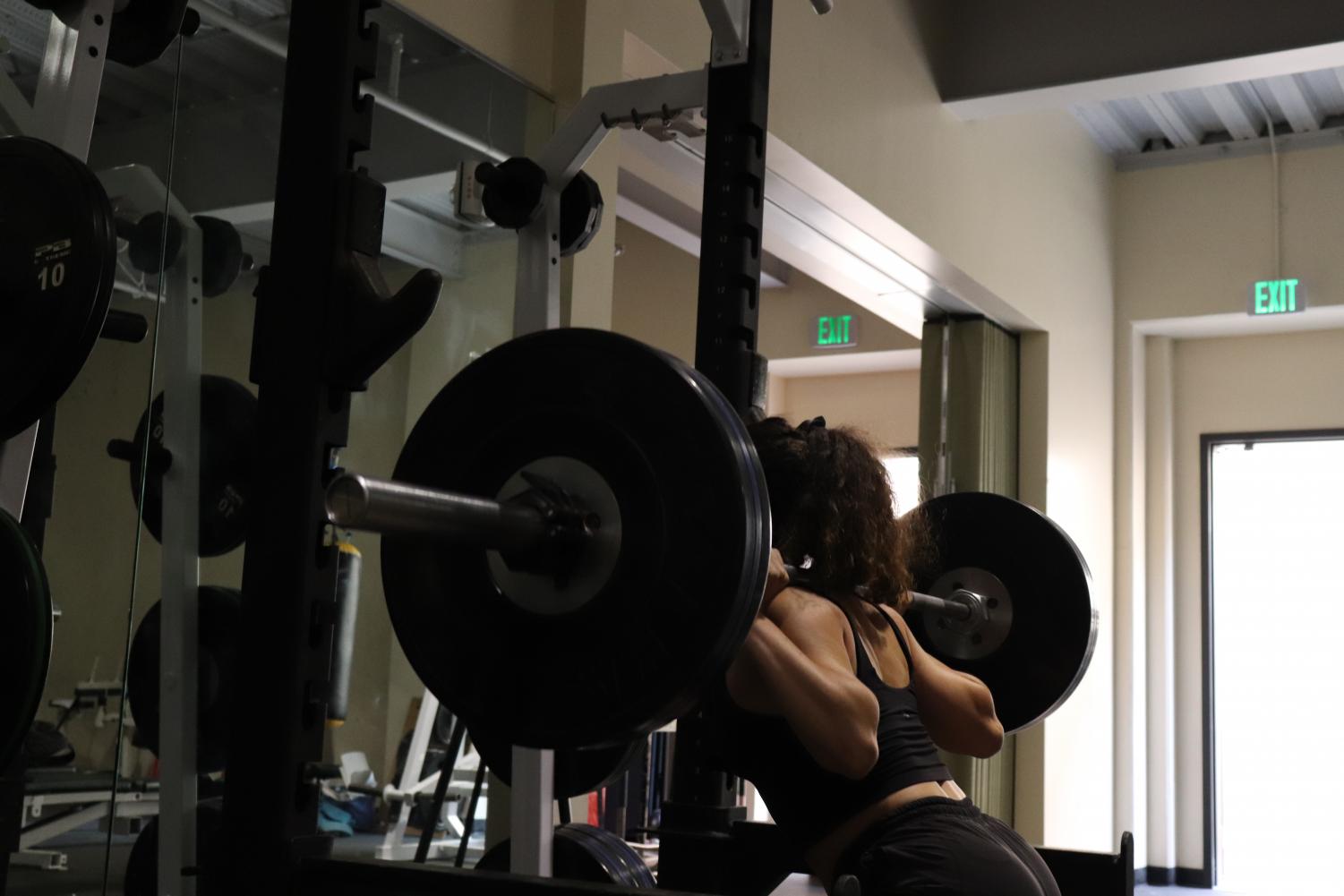Women in the Weight Room
Breaking the barriers of stigmas and stereotypes, an increasing number of women can be found in the weight room with the intention of lifting to both enhance their physical health and improve their mental health.
October 15, 2021
In the basement of the Peery Family Center, blasting music and the sound of clanging metal radiates through the weight room. Like many gyms, upon glance, the Paly weight room is a mainly male-dominated space. Taking a closer look, however, there are a few women who are routinely in the Paly weight room, taking advantage of all the benefits lifting can provide.
One such student is senior Wallie Butler, who has been lifting since sophomore year. Before the sport became a passion, she was on the cheerleading team for Paly where she became familiarized with weight training as a part of the team’s training routine. After she stopped cheering, she sought alternative ways of staying active and gravitated towards the weight room since it was accessible at Paly.
Butler sees weightlifting as somewhat of a creative endeavor where she can play around with how she spends her time in the weight room.
“Through trying so many different exercises, I usually pick my favorite ones and the ones that get me the most active that day,” Butler said. “I build my own routine and do what is best for me.”
Senior Gabi Winer is also a regular in the gym, spending her time there with the intention of building muscle and working out to get stronger physically and mentally.
Winer’s introduction to weightlifting began during her sophomore year as a mode of mental and physical recovery.
“I was in recovery for an eating disorder and I needed to gain weight,” Winer said. “I started to get into lifting heavy weights in order to gain my weight back in muscle.”
She started going to the gym six times a week, determined to strengthen and heal her body, and more importantly, her mind.
 “My workout routine has been subject to change for a while as I’m still getting to know my body and what works best for me,” she said. “So far, alternating muscle groups has been working well for me because it allows me to give my body time to recover.”
“My workout routine has been subject to change for a while as I’m still getting to know my body and what works best for me,” she said. “So far, alternating muscle groups has been working well for me because it allows me to give my body time to recover.”
Winer’s experience with weightlifting has created a pivotal change in her mentality towards exercise.
“I learned that exercise is for building yourself up, not breaking yourself down,” Winer said.
Winer prefers to work out alone most days, simultaneously using the time she lifts to be vulnerable and transparent with herself.
“My workout is a time for personal reflection and it’s a time I get to check in with myself and sort through my thoughts,” Winer said.
Lifting has given many the opportunity to learn more about their bodies and to experience the mental health boost exercise can provide. Senior Khushi Agarwal has developed an appreciation for how much healthier, both physically and mentally, she has become since she has started to lift during quarantine.
“Lifting has improved my confidence,” Agarwal said. “I still have a ways to go, but it gives you a different perception of yourself and makes you feel more respected and better overall.”
She started out with doing simple workouts with her dad, and then gradually started incorporating weights into her routine.
Initially, Agarwal found the environment of the weight room intimidating because she had only ever lifted alone in her home gym. Now, she lifts in the Paly weight room as many mornings as possible.
“Being around other people lifting was a bit scary at first, however, I’m pretty confident in my skill set as a lifter because I’ve been doing it for a bit,” Agarwal said.
After becoming more comfortable with the weight room environment, Agarwal greatly appreciates the encouraging and respectful environment she has experienced in Paly’s gym thus far.
She found that while the atmosphere of a public and at-home gym varied significantly, one commonality was that she did not have to feel self-conscious and could focus on herself and her workouts.
“When I went, everything was normal, I felt like I was working out alone,” she said. “There are a lot of other people, but no one really pays attention to what you do.”
Amongst those in the lifting community, there is a mutual respect that those who lift have for each other. Many acknowledge that they are there for similar reasons: to become stronger both physically and mentally, and reinforce each other to achieve those goals.
“We all understand that we’re just trying to get better for ourselves,” Agarwal said.
However, for most females, gaining recognition and respect from other lifters is more challenging.
As a female participating in a heavily male-dominated activity, Agarwal found herself in instances where people, especially males, questioned her skill and commitment as a lifter.
“There are many times that I’ve told a guy that I lift, and the initial assumption is that I’m in there to do squats or abs,” she said. “I have to prove myself as a lifter.”
In order to try and combat these assumptions, Agarwal uses the knowledge she has gained from lifting to discuss it with those who may question her.
“If a guy ever questions me, I just ask him, ‘what’s your split,’ which is the workout structure,” she said. “Right when I tell them my split, they understand that I know how lifting works, and then they respect me.”
Although Agarwal is somewhat unfazed by sexist comments made towards her about lifting and finds satisfaction after proving herself to anyone that doubts her skills, it is still a sensitive topic.
Gabi Winer has also experienced sexism directly in the weight room, whether it be getting stared at while doing certain exercises or receiving discouraging comments from males around her.
“What really pisses me off is when I get ‘mansplained’ about lifting,” Winer said. “Men have come up to me all the time to correct my form or to tell me I’m going too hard and I need to lighten the weight. In moments like these I really just try to hold my ground by telling [the men] ‘I got this.’”
With her experience in the male-dominated weight room, Butler likes to challenge herself to match the pace of her male counterparts and uses this as motivation.
“I feel like [having boys in the weight room] pushes you because whenever I go in there is usually a guy lifting a lot heavier than me [and] that motivates me to do better,” Butler says.
The crowded room and high-energy environment of the weight room encourages Butler to get better every day.
“I’m someone who is very competitive around other people, so the competition is definitely a big motivator,” Butler said.
The experiences that women have in the weight room can be taxing with the prevalence of sexism many women face in such a space. Everyone reacts differently to these circumstances, whether it is having to prove their knowledge of weightlifting or demonstrating their capability of lifting heavy. Oftentimes, the frequency of sexism in the weight room results in discomfort for female lifters and leads many women to shy away from going to the weight room, contributing to the lack of female presence in the gym.
Additionally, general societal stereotypes and norms have also made women reluctant to work out for strength and muscle. The stigma against women weightlifting attributes becoming bulky or muscular as a negative outcome; it is seen as less feminine and desirable. These views tend to dissuade women from considering weightlifting in the first place.
Winer is passionate about speaking out against this stigma and sees muscles on females as something that should be appreciated.
 “The truth is if we all ate the same diet and did the same workouts, we’d all look completely different to one another,” Winer said. “Having muscles is something that should be celebrated and embraced. I personally love my muscles because it’s tangible proof of my hard work.”
“The truth is if we all ate the same diet and did the same workouts, we’d all look completely different to one another,” Winer said. “Having muscles is something that should be celebrated and embraced. I personally love my muscles because it’s tangible proof of my hard work.”
Her insight and knowledge in the weight room have earned Winer the position of Paly’s Weightlifting Club co-president.
She was the first female lifter to join the club after being disappointed with the lack of female representation and participation in the Paly weight room and weightlifting club.
“As co-president, my main goal is to recruit more women to the club and encourage women to feel more confident in the gym,” Winer said.
The weightlifting club welcomes new members of all levels, from beginners to experts, with open arms. As a club leader, Winer strives to make herself available to her weightlifting peers if they are in need of guidance in the gym. She hopes her availability and leadership role will also help attract more girls to the club, who may be in search of a way to get started.
“If anyone needs me to check out their form I will,” Winer said. “I’ll even personally train someone to help them reach their own specific goals, or take someone through my workout with me.”
As a club leader, Winer hopes to be a role model for other girls as well as everyone else in the weight room. She has also started her own fitness Instagram account where she posts about her lifting journey and progress with the intention of inspiring others to join the community and repping female presence in the weight room.
By constantly encouraging her female peers, shedding light on her story, and exhibiting the benefits of weightlifting, Winer is hopeful that many girls will try out the weight room and achieve their goals through lifting routines
“I think the main reason why we don’t see as many women in the gym is because of a lack of education and experience,” she said. “I hope that by teaching my friends some lifts and bringing them through my workouts that they’ll gain enough confidence to go to the gym by themselves.”
Although women in the weight room are outnumbered by men, the women who lift provide representation, knowledge, and access to other women. Developments such as female leadership roles in the weightlifting club reflect a shift towards more inclusivity and towards creating an activity that keeps both men’s and women’s interests in mind. At Paly, the weightlifting community has grown rapidly with the aim to embrace everyone regardless of gender. With this in mind, those in the weight room have the interest in supporting and motivating each other towards the common goals of physical and mental strength, and hopefully, with growing numbers in the weight room, this outcome may be truly experienced by everyone at Paly.
— Tips for Beginners —
Building the courage to start lifting, or just walking into a gym can be hard and intimidating. For this, Winer has some words of advice for any newcomers.
“I’d say the biggest word of advice I could give to girls looking to start lifting is to just jump right in. The hardest part of working out is just getting started,” she said.
She acknowledges that the beginning can be tough, but once the hard work starts to pay off, it’s all worth it.
“The first couple of times in the gym is gonna suck and it’s gonna hurt, but as you get stronger the more you’ll fall in love with the process,” she said.
Lifting weights is something that also requires skill and attention. Butler has learned her correct form after
When putting too much pressure on the wrong parts of your body, there may be consequences.
“One thing to say to beginners is to really make sure you’ve got your form down. You can get very injured if you try to lift heavier weights with incorrect form,” she said.
Agarwal also puts to light the importance of researching about lifting prior to entering the gym
Having a goal that you are working towards as a beginner is also important, and helps create a path to follow.
“Figure out what is good for you and what your goals are,” Agarwal said. “If you can identify your goals, people could help you reach them.”

